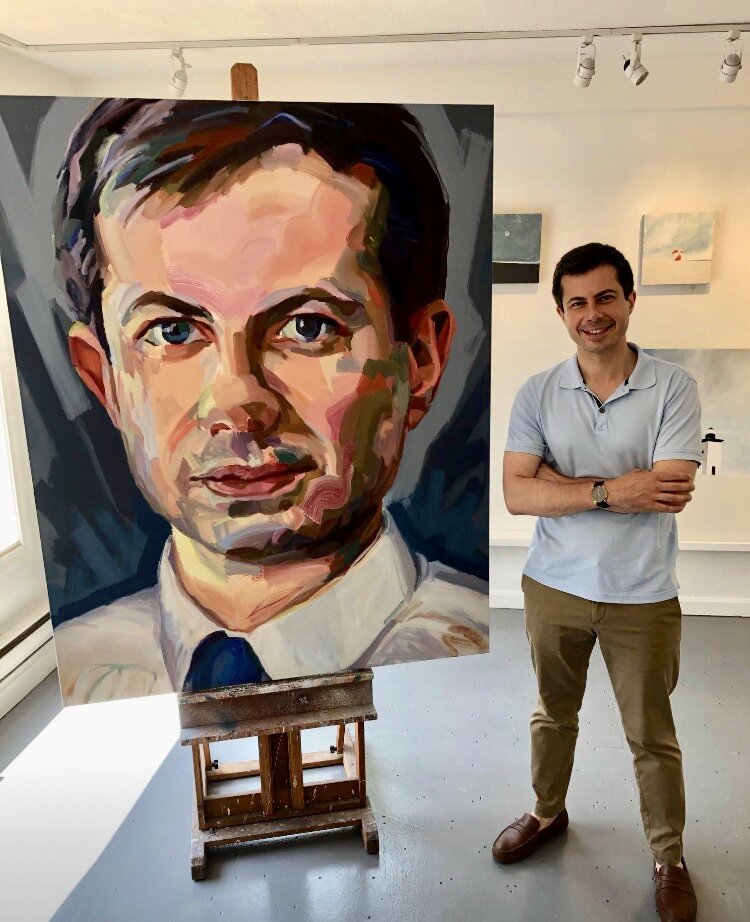Richard Jones meets Jo Hay
Richard Jones, Queer Forty, December 2019
Jo Hay is a painter, not just any painter, but one that has recently painted some of the most iconic people of the last few years, including Ruth Bader Ginsburg, Pete Buttigieg and Hilary Clinton.
I had the immense pleasure to sit down and Talk with Jo about her work and what she will be getting up to in the future.
Richard Jones: Hi Jo, thanks for sitting down with me. I have always loved your stunning and amazing giant portraits – tell me a little but about you?
Jo Hay: Hi Richard, thank you very much for taking such an interest in my work.I am a British-American painter born in 1964 in Newcastle-Upon-Tyne England.
I studied in London for my Bachelors degree and for a time, I was a magazine art director which brought me to New York. There I studied painting and drawing at the Art Students League and eventually enrolled in the masters program at the New York academy of Art.
I really love New York and made the most of constantly absorbing as much of the visual arts as I could when I lived there. But I knew that I needed to step away from it all to be able to find what it was that my work was about. I am currently living and working in Provincetown.
RJ: How did you find that you were an artist, or loved art?
JH: My mother had a subscription to a monthly magazine that was so beautifully produced it was like a gorgeous, slim book with a thick glossy cover. Each month focused on a different artist like Manet, Van Gogh, Rembrandt… I would look at it each month and I remember experiencing a very clear sense of familiarity and kinship with what I saw and felt instinctively that I needed to do that too.
I was fascinated by color and perspective and the aliveness of the figurative work. Of course, my childhood-self suffered many hours feeling confused and infuriated that the ability to paint and draw proficiently didn’t just naturally flow from me without practice. Luckily, this deep discomfort became the drive to get out in the world and learn as much as I could.
RJ: What has your art career been like?
JH: I tend to look at my career as being a constant search, one way or another, with the ultimate goal being to successfully combine my natural method of painting with a personally relevant subject matter. I felt this would result in the greatest visual and emotional impact in any given piece.
Initially I thought the answer was to improve my technique, feeling weak in that area, and would scour museums and books… the golden days pre internet… searching for the old masters secrets of painting.
In grad school I realized I had enough technique and needed to focus on the content, or in other words, ‘what to paint.’ Since then, I have painted every subject possible in an effort to find my subject. Throughout I always returned to figurative work.
Eventually it dawned on me to trust this impulse, narrow my focus and really push this single subject in an effort to make something more exciting and visually compelling than I had before.
RJ: How did you find Provincetown?
JH: I was reluctantly brought to Provincetown 14 years ago. My partner at the time had come here each year since her teens and she insisted we come too. The city girl in me wanted none of it but I eventually relented and six hours later as we turned off the highway and saw the magnificent, sweeping view of the bay and the glorious gaggle of houses swinging west, I was suddenly wide-eyed, speechless and head over heels in love.
RJ: You have painted some amazing paintings of some very high profile people, how did that start?
JH:The Persisters series, which are portraits of contemporary, trailblazing women in their pursuit of justice, started as a reaction to the results of the 2016 presidential election. For the first time in my life I felt physically unsafe and began looking for women who could give me both solace and explain to me what was happening to the country and with the government.
Rachel Maddow and her efforts to understand and convey the Trump/Russia connection was the first portrait. The series continued with Ruth Bader Ginsburg who has spent her life seeking equality for women and then Emma Gonzales a student survivor of the Margery Stonemason Douglas High School shooting.
It was after experiencing Emma being suddenly thrust onto the world’s stage that, as well as honoring these women, I realized that in these portraits I wanted to somehow encapsulate the energy and potency of this particular moment in history.
RJ: Is there a favorite?
JH: I’m not sure there is a favorite. I think I still tend to look at them all very technically, seeing successes and failures in each one with regard to particular areas of paintwork.
I try to keep my work feeling as alive as possible. To do this I rely on paintwork appearing to be in a state of both resolve and collapse simultaneously. Up close it can just look like a group of random paint marks and unexpected color but stepping back it comes together as believable, solid form.
That said, I do have a soft spot for the painting of Rachel Maddow as she was the first of this series. For myself I achieved an overall sense of cohesion in this painting unlike anything that came before. Technically it set the bar for me for the rest of the series.
RJ: Who do you really want to paint next?
JH: The nature of this series seems to be that the subject is often chosen for me, or at least it is presented as a very clear option. This has become an integral part of the process. The sense of urgency and insistence of a particular subject fuels both the making of the painting and from what I can see from witnessing reactions to these paintings, it adds to the experience for the viewer. I have just begun to paint Marie Yovanovitch.
RJ: Where can people see and buy your paintings?
JH: Ultimately I am aiming to keep these paintings together as a group and would like very much to find a permanent place where they can be viewed, particularly by women, who have responded so passionately to these paintings at this time. I have had several people suggest academic institutions which I am certainly interested in. Though I am eager to keep these paintings visible at this time, I am also very happy to wait for the right venue.
Pete Buttigeig with his portrait by Jo Hay
Ruth Bader Ginsberg by Jo Hay
Greta Thunberg by Jo Hay
Ayanna Pressley by Jo Hay





